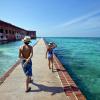Black history is Florida history. When you visit Florida, you can do a deep dive into writer Zora Neale Hurston in her hometown of Eatonville. You can retrace the steps of greats like Louis Armstrong, Ella Fitzgerald and Muhammad Ali in Miami’s Overtown neighborhood. And you can catch a baseball game at Jackie Robinson Ballpark.
But until recently, one of Florida’s largest contributions to African-American history has gone largely unrecognized: its role in the original Underground Railroad.
“A lot of times we relegate Black history to February,” said Thomas Jackson of Fort Mose, an important landmark on Florida’s Black Heritage Trail. “If you don’t get it during February, then you probably won’t get it.”
What was Florida’s role in the original Underground Railroad?
You’re probably familiar with the Underground Railroad, an informal network of abolitionists and safe houses that helped Black people escape slavery by fleeing from Southern states into Northern states or Canada. Between 1810 and 1950, approximately 100,000 freedom seekers found refuge via the Underground Railroad. Harriet Tubman alone helped free about 70 enslaved people.
But centuries before Tubman was even born, enslaved people sought freedom via another Underground Railroad—one that traveled from North to South. Enslaved people from modern-day Georgia and the Carolinas journeyed to Florida in search of freedom. To understand why, we’ve got to go back more than 500 years.
Why did enslaved people seek freedom in Florida?
In 1513, explorer Juan Ponce de León made landfall near modern-day St. Augustine and claimed La Florida for Spain. Spanish authorities had exploited African labor in the New World long before the British famously brought enslaved people to Virginia in 1619.
But there were brief periods when Spanish Florida offered refuge to freedom seekers. This was a strategic move on Spain’s part, in an effort to combat British forces and Protestantism in the New World. In the late 17th century, the Spanish informally spread word that Blacks who escaped British plantations could live freely in St. Augustine, provided that they: (1) swore allegiance to the Spanish crown, (2) converted to Catholicism and (3) for men, completed a period of military service.
This original Underground Railroad was less formal than its 19th-century counterpart. There were no established safe houses or conductors. Instead, freedom seekers—many of whom had spent their whole lives on a plantation—navigated the unfamiliar terrain with help from Native Americans, in particular the Yamasee.
“You had an area that was completely undeveloped, so once you got past the border, you were really in a no man’s land,” said Miami historian Paul George. “You didn’t have the Harriet Tubmans and the others who would facilitate that. They were really on their own. How they did it was beyond me.”
And yet, they did.
The first recorded group of freedom seekers—eight men, two women and a 3-year-old child—arrived in St. Augustine in 1687. The men worked for wages at Castillo de San Marcos, helping to block British access to Florida. The women found paid employment around St. Augustine.
This migration grew, to Spain’s advantage: The newly freed denizens contributed militia support and skilled labor to Florida, while simultaneously weakening the British plantation economy. In 1693, King Charles II of Spain issued a proclamation officially declaring Florida a sanctuary from enslavement.
Fort Mose was the first legally sanctioned community of free blacks in what would become the United States. It also had a militaristic role as St. Augustine’s northern defense against invading British. Today, the site is a Florida state park, where historical reenactments are sometimes staged.
- FSP Living History
Then in 1738, Spanish Governor Manuel Montiano decreed the founding of Fort Mose (pronounced mo-ZAY) the first legally sanctioned settlement for formerly enslaved people in what is now the United States. Fort Mose provided sanctuary for about 100 Black men, women and children, and its militia of free Blacks protected St. Augustine’s northern border from the British.
“People think it was undercover,” said Thomas Jackson, a reenactor at Fort Mose and a founding member of the Fort Mose Historical Society. “It was undercover getting here, but once you got here… you could live freely at Mose. St. Augustine was a very cosmopolitan city.”
But not everyone survived the journey to St. Augustine. Unknown numbers of freedom seekers perished en route, while others established maroon societies in remote coastal areas.
Was St. Augustine the only destination for freedom seekers in Florida?
No, it wasn’t. The British destroyed Fort Mose in the 1740, during the Battle of Fort Mose, also known as Bloody Mose. The fort was rebuilt in 1752, and Blacks continued living freely around St. Augustine until 1763. That’s when Spain ceded Florida to Great Britain as part of the treaty that ended the French and Indian War. In turn, former Fort Mose residents and other freedom seekers ventured farther south to present-day Miami. They navigated the swampland with help from the Seminoles, who had an interest in thwarting British encroachment in Florida. Blacks who formed alliances or intermarried with Seminoles are known as Black Seminoles.
“The attraction was the proximity of the Bahamas,” George said.
From Miami and the barrier island of Key Biscayne, freedom seekers boarded abolitionist boats for Spanish-controlled Cuba. Others found refuge in the Bahamas, where they joined communities of other formerly enslaved people. The passage from Southern Florida to Caribbean islands is known as the Saltwater Underground Railroad, or simply the Saltwater Railroad.
Between 1821 and 1837, about 200 Black Seminoles journeyed from South Florida to Andros Island in the Bahamas, where chattel slavery had been outlawed.
“They were welcomed,” George said. “They were embraced by others who had somehow survived that treacherous move. They had this bond, and it became an extended family.”
This family extends even today, as descendants of Black Seminoles still inhabit Andros Island.
Where are some places in Florida that commemorate this history?
While the story of Florida’s role in the Underground Railroad remains largely fractured, here are some destinations where you can further explore this topic.
● Angola: From 1812 to 1821, freedom seekers formed a maroon community in present-day Manatee County. Here you can explore sites and events related to the community.
● British Fort: In the late 18th and 19th centuries, Blacks from Georgia and the Carolinas found refuge in this enclave located in Apalachicola National Forest. Here, they lived in cooperation with the Seminoles. In 1816, Major General Andrew Jackson ordered Negro Fort, as it was also called, to be destroyed. During the demolition, approximately 300 Black men, women and children were killed. Two years later, Jackson instructed Lieutenant James Gadsden to build a new fort on the site of the old Negro Fort. We know it today as Fort Gadsden.
● Cape Florida Light: Near this lighthouse at Bill Baggs Cape Florida State Park, you’ll find a modest wood-framed sign marking Key Biscayne’s role in the Saltwater Underground Railroad. It was at this site that boats from the Bahamas picked up Blacks to take them to freedom.
● Castillo de San Marcos: At this 17th-century fort in St. Augustine, freed Blacks worked for wages to stave off the British. Walk the limestone structure any time of year, or time your visit for around special event.
● Fort Jefferson: Located 70 miles west of Key West, Dry Tortugas National Park is accessible only by boat or seaplane. The remote park is prized for its unparalleled birdwatching, snorkeling and camping experiences. But Dry Tortugas also holds a dark history. The park’s centerpiece is Fort Jefferson, built on Garden Key between 1846 and 1875 to shore up U.S. coastline against threats in the Gulf of America. Enslaved Africans were exploited to construct the fort. In 1847, seven freedom seekers fled Garden Key. After a harrowing journey, the men were eventually captured and returned to enslavement on Garden Key or Key West. It wasn’t until 1863, when hundreds of military convicts were sentenced to hard labor on Garden Key, that slavery on the island was discontinued. Today, you can walk the grounds of this massive fortress, whose chilling history is in contrast to its surrounding natural beauty.
● Fort Mose Historic State Park: This 40-acre waterfront site in St. Augustine sits on the site of America’s first legally sanctioned settlement of free Blacks. Explore the visitor center, museum and boardwalk year-round. Or plan to visit during one of the annual reenactments—Flight to Freedom and Battle of Bloody Mose—when history comes to life.
● Fort Pickens: This antebellum fort in Pensacola developed a reputation as a gateway to freedom.
Why didn’t I learn about this in history class?
For a few reasons. The original Underground Railroad was less formal and shorter-lived than its mid-19th century, Northern-bound counterpart.
Secondly, history books are written by winners. After Great Britain took control of Florida in 1763, tales of the cross-cultural cooperation between the Spanish, Blacks and Native Americans were largely forgotten.
“This is important because it illustrates that the Anglo version of U.S. history leaves out half a continent, from Florida to California, where the Roman legal system and Catholicism granted freedom to the enslaved if they fled from Protestantism to become Catholic—long before anyone ever ran to Canada,” said historian Jane Landers, director of the Slave Societies Digital Archive at Vanderbilt University and one of the country’s leading experts on the Underground Railroad.
While a handful of early researchers, including Zora Neale Hurston, documented Fort Mose, the original Underground Railroad was sparsely acknowledged until recent years.
Even Jackson, the Fort Mose reenactor and St. Augustine native who grew up in the shadow of Castillo de San Marcos, didn’t learn about Fort Mose until college.
“The old folks used to tell us, ‘We had a fort, too,’ But we always thought it was a fable,” Jackson recalls. “We just need to tell the story.”

























